VIA's Dual Core Nano & VN1000 Chipset Previewed
by Anand Lal Shimpi on November 15, 2010 12:26 PM ESTGraphics Performance: Surprisingly Potent
Preparing to test the VN1000 was a lot like deciding to go see a John Cusack movie. You assume it’s going to be bad, but every now and then you might be pleasantly surprised. My expectations were thus very low.
The last VIA platform I had wouldn’t complete most 2D benchmarks in Windows 7 due to driver issues and general instability. That’s why you only see a few scores from the old Nano in Bench. The VN1000 was completely different.
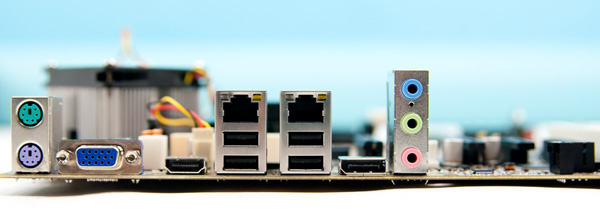
The VIA VN1000 Reference Board featured VGA, HDMI and DP outputs
Despite the typical omg-thisisntATI/NVIDIA error that some games always throw, the VN1000 actually ran everything I threw at it. I didn’t notice any rendering errors or any driver compatibility problems. I didn’t run every last title on the market, but I ran a number that I honestly didn’t expect VIA to be able to handle. And the VN1000 did.
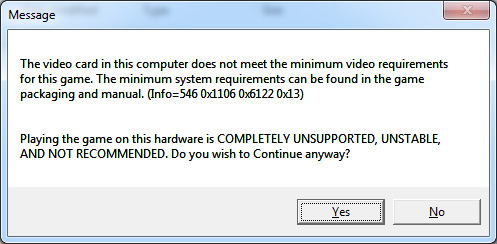
Dragon Age, Modern Warfare 2, BioShock 2, World of Warcraft and even Starcraft II all ran on the VN1000. Not only did they run, but some of them actually ran pretty well.
As with all integrated graphics I had to test at the lowest possible quality settings at 1024 x 768 across virtually all titles. I should add that although the Chrome 520 GPU does support H.264 acceleration, I couldn't get it working with the driver drop I had on my test platform. CPU utilization would be low but I still dropped frames. I suspect this is a driver or software compatibility issue which I do expect VIA to rectify before the platform ships.
First let’s compare directly to Atom and ION:
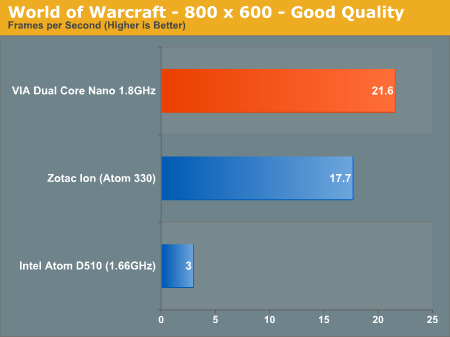
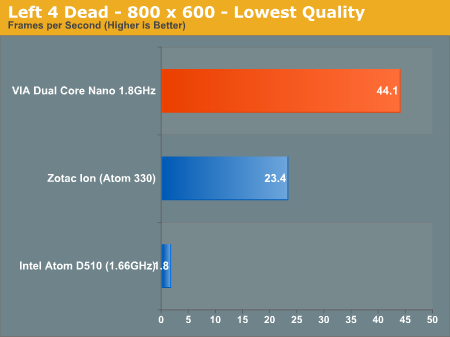
The Atom comparison is dramatic. Intel hasn’t taken GPU performance seriously for years and Atom was the last example of that mentality. What’s even more surprising however is that the Chrome 520 GPU is actually faster than NVIDIA’s ION.
Clearly the VN1000 can hold its own in the Atom space, so let’s set our sights a little higher. How about Clarkdale?
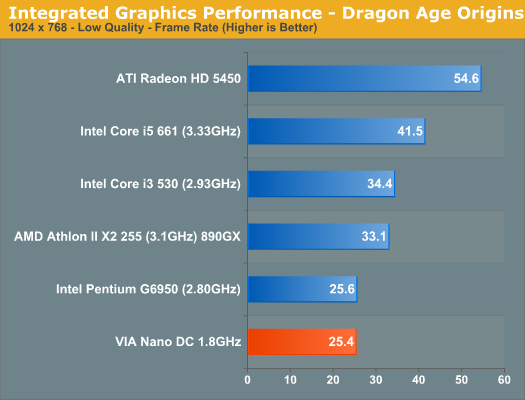
Under Dragon Age Clarkdale puts VIA in its place. The Core i3 manages a 40% performance advantage here. But look at a lower end competitor: the Pentium G6950 is no faster than the dual core Nano/VN1000 platform!
It gets even more ridiculous under Modern Warfare 2:
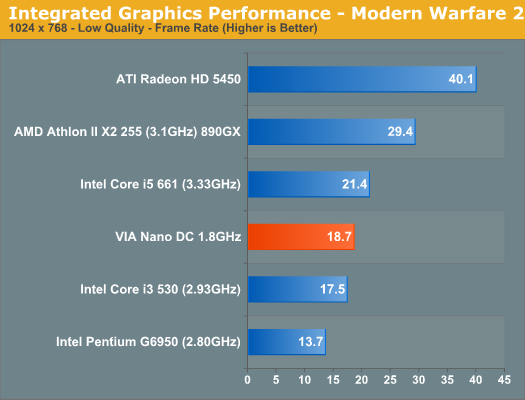
VIA’s platform is actually faster than Intel’s Core i3 with integrated graphics. The same holds true under World of Warcraft:

Here the Nano is able to even equal the performance of the Core i5 661. Pretty impressive.
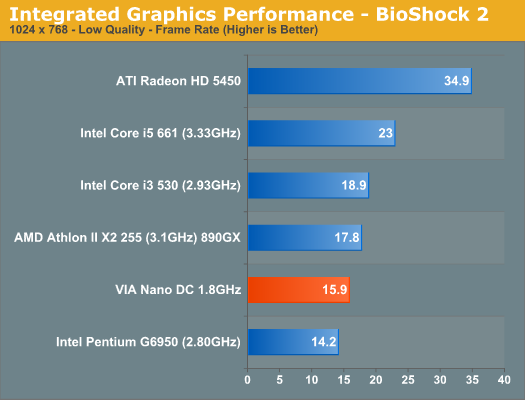
The VIA platform didn't handle BioShock 2 very well, but it's still able to get the Pentium G6950 a run for its money.
I was particularly curious to see how Starcraft II ran on the platform. Starcraft II can be both GPU and CPU limited within a single play session simply depending on what you're doing. Scrolling around the map and just watching your units gather resources tends to be GPU bound on mainstream or faster systems. Big battles however are almost always CPU bound. To showcase both we have two benchmarks. Our GPU test is a 2v2 with a lot of scrolling around the map, while our CPU test is a 3v3 monitoring frame rate during a huge battle involving all of the players.
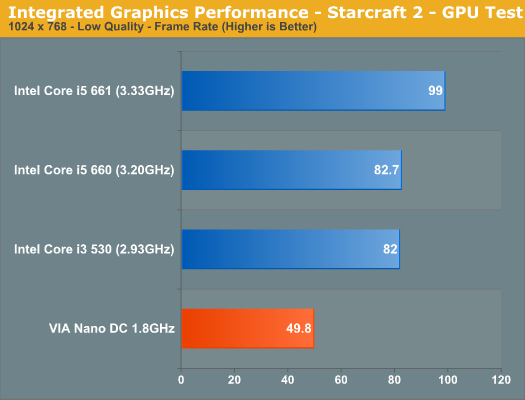

VIA's Chrome 520 is definitely fast enough for Starcraft II. At low quality settings, the VIA platform can manage nearly 50 fps in our GPU test. That translates into smooth gameplay while moving around a map and selecting units. It's the CPU that's holding back the platform. In large battles the Nano DC drops down below 10 fps and choppiness ensues. Intel's Clarkdale graphics enjoys around 2x the performance in our CPU test and about 60% higher frame rates in the GPU test. Intel has done a lot of work with Blizzard optimizing for SC2, so strong performance here isn't surprising.
Overall, you can color me impressed. This is real world, usable performance. Even the experience under Windows wasn’t half bad. Moving windows around was sometimes choppy but for the most part it could’ve been any other integrated graphics platform that I was using. Drivers installed fine and I didn’t get any strange crashes or compatibility errors during my limited testing period.
I have to say that this is probably the first VIA platform that has delivered not only competitive but impressive graphics performance in years. Let’s take a look at the CPU performance.










54 Comments
View All Comments
tipoo - Monday, November 15, 2010 - link
So what I take from this is that performance usually beats Atom+Intel IGP, but that 65nm fabrication process means they aren't competitive in power draw.IntelUser2000 - Monday, November 15, 2010 - link
Sorry, AMD on the same 40nm TSMC will have similar performance for CPU, and have far less TDP.No, Via's designs are just years and years behind. They probably need 22nm RIGHT NOW to be competitive.
tipoo - Monday, November 15, 2010 - link
Huh? This is 65nm, and like you yourself said AMD's is on 40nm. Its not the same like you said. But you are right in saying that it also needs architectural improvements.DanNeely - Monday, November 15, 2010 - link
40nm will help a lot on load power, but until they implement power gating (and this is somewhere Intel still leads AMD significantly) idle power is going to remain a major liability.chucky2 - Monday, November 15, 2010 - link
Forget the speed of this thing for a moment, and the power consumption:What about stability and compatibility?
If VIA is going to try and make a come back - of any type - then reviewers need to do much more stability and compatibilty testing than with products based on Intel or AMD solutions, as those were the major issues with VIA in the past. It wasn't that they had bad speed or high power consumption of the money you paid for them, it's that they had an unacceptable level of stability and compatibility issues.
For anyone familiar with the VIA of old, that will be the benchmark they're weighed against before speed or power consumption even come into question. Doesn't matter how fast something is, or how little power it consumes, if there's a good chance it's going to crash on me with regular usage, or, if the common component I'll be plugging into it is going to have issues (because of VIA) or crash (because of VIA).
Sure hope VIA learned from its past history.......
Chuck
strikeback03 - Monday, November 15, 2010 - link
Well this is labeled as a preview, maybe more of that will come when they have final shipping hardware.ProDigit - Monday, November 15, 2010 - link
Please, when you review bobcat, compare it to this nano chip!The results might prove interesting.
I believe the Nano could have better CPU, while worse GPU ratings than the AMD one.
Power consumption of the Nano @40nm should be between 28W and 40W idle/load; unless they are able to optimize the nano, and integrate some overclocking (like intel's turbo boost technology).
It'd be nice to see some downclocking or core disablement on this cpu too!
Via has much to invest in if it wants to be competitive with Intel!
nitrousoxide - Monday, November 15, 2010 - link
It will not out-perform Fusion APU, which has approximately 80% the performance of current low-voltage Athlon II X2 CPUs, that is really impressive power.Zingam - Monday, November 15, 2010 - link
nvidia should buy themShloader - Monday, November 15, 2010 - link
Actually... Yeah! If not that then at the very least create a strong partnership with them. Were that to happen a lot of the Linux compatibility questions go right out the window (unfortunately letting in a lot of power consumption questions). nVidia needs to team up with a player in the x86 CPU market and insure a platform for their discreet graphics + chipset business. Remember it was nVidia that led the way to dual channel memory on the x86 platform. Get that DDR3 memory controller integrated along with an integrated nVidia GPU on a 22 to 32 nm process. I would actually buy something for HTPC if both those companies shared the helm. nVidia's additions would make a lot of the core performance questions irrelevant for me. Just give me enough cuda power to play my vids while speeding up h.264 encoding.